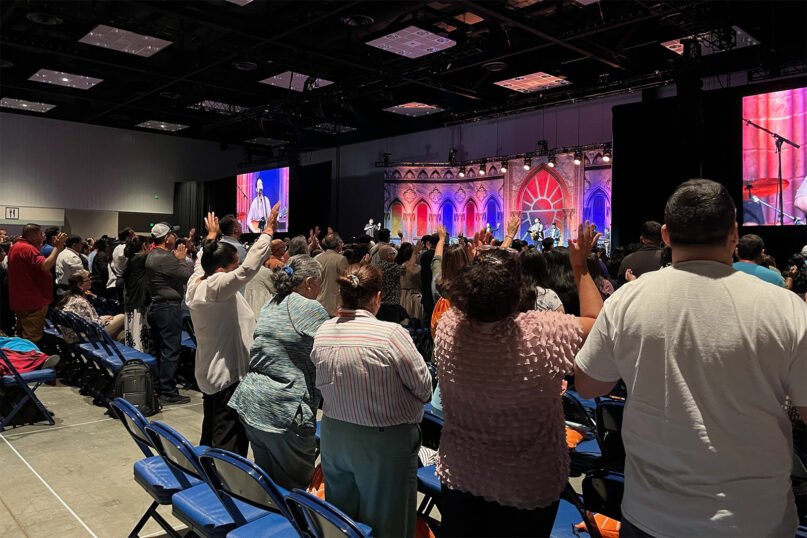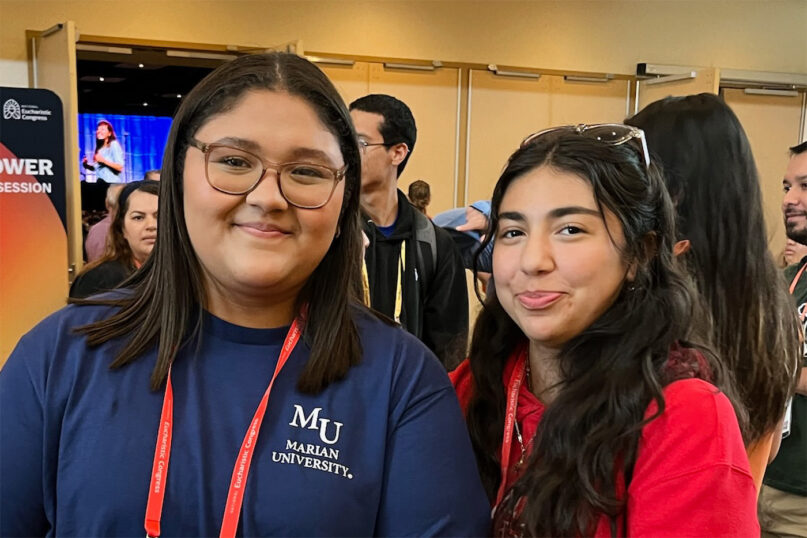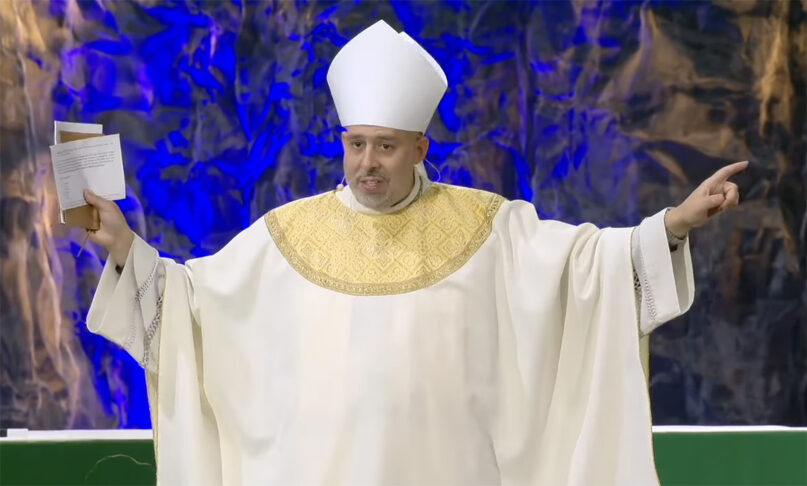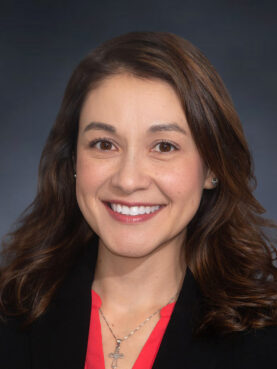INDIANAPOLIS (RNS) — When Bishop Joseph Espaillat, an auxiliary bishop in the Archdiocese of New York, took the stage in front of hundreds of Spanish-speaking Latino Catholics at the National Eucharistic Congress on July 20, he was ready to deliver some hard truths.
“Many of you don’t engage in formation,” he challenged in Spanish. “Ouch,” the crowd yelled back.
“Many of you don’t study.” Another ouch. “Many of you don’t even read the Bible,” he thundered.
Despite only becoming an auxiliary bishop in 2022, Espaillat has quickly emerged as a highly visible leader, known among Catholics for his engaging speaking appearances and by secular media who took notice of a bishop who raps. Now 47 years old, Espaillat is the youngest U.S. bishop, the first Dominican-American bishop, and one of few Latino bishops born in the U.S.
The crowd’s spirited responses came after Espaillat invited them to respond to him with “Amen” or “Ouch.” Regardless of what they chose, Espaillat said, “You can’t stay quiet because this is the problem with the Hispanic church. We stay quiet.”
So, the crowd was ready with an “ouch” when they heard that the U.S. Conference of Catholic Bishops had not yet translated their new national pastoral framework for youth and young adult ministry. (The document is now available in English and Spanish.)

National Eucharistic Congress attendees listen to music prior to Bishop Joseph Espaillat speaking Saturday, July 20, 2024, in Indianapolis, Indiana. (RNS photo/Aleja Hertzler-McCain)
But Espaillat had come prepared to make the document’s lessons accessible to them, retelling with call-and-response the Bible story of Jesus’ appearance to his disciples on the road to Emmaus that is woven through the document’s recommendations.
“We need to listen. Dad, mom, uncles and aunts, grandfathers and grandmothers, I’m sorry, but many of you don’t know how to listen to the children,” said Espaillat, summing up a recommendation from the document.
“If we don’t learn how to speak to our children, well, then, we’re going to continue on the same path, and we’re going to continue to lose them,” Espaillat warned.
Espaillat was speaking to an urgent reality in the U.S. Catholic Church. While Latino Catholics are still a minority in the broader church, about 60% of Catholics under 18 are Hispanic.
But even as the future of the church looks to be Hispanic, Latino young adults are turning away from the faith — 18- to 29-year-old Latino adults are the only Latino age cohort where the religiously unaffiliated now outnumber Catholics. And even though slightly more than half of them grew up Catholic, only 30% still are.
Espaillat, who was director of youth ministry in his archdiocese for a decade before becoming bishop, hopes to turn the tide.

Valentina Guerra Peña, left, and Guadalupe Soberanes. (RNS photo/Aleja Hertzler-McCain)
Valentina Guerra Peña and Guadalupe Soberanes, who watched Espaillat address an English-speaking Catholic audience with their youth group on July 19, agreed that Espaillat is a “role model” and “inspiration” for young teenagers.
“We usually tend to fall asleep in talks,” Guerra said, “and he just wakes us up with his spirit, and it’s really fun.”
“He gets to the point. He doesn’t sugarcoat anything,” Soberanes agreed.
Nabil Tueme, a senior research associate and sociologist at Springtide Research Institute, highlighted the challenge Catholic leaders face in ministering to Latino youth born in the U.S., especially given that, for English speakers, the assumption that all Latinos speak Spanish can be “profoundly alienating,” yet Latino youth are still looking for ministers to “understand and celebrate their ethnicity.”
Many Hispanic Catholic youth still have few opportunities to see their ethnic experience reflected in their priests and bishops — while Latino adults make up one-third of the church, only 10% of U.S. bishops are Hispanic or Latino, roughly mirroring the proportion of U.S. priests who are Hispanic or Latino.
The 12,000 high schoolers who witnessed Espaillat give the closing homily at last year’s National Catholic Youth Conference responded with high enthusiasm, said Christina Lamas, the executive director for the National Federation for Catholic Youth Ministry, which sponsored the event. Some even seemed to mistake him for the pope, she told RNS.

Bishop Joseph Espaillat preaches during the National Catholic Youth Conference in Indianapolis in Nov. 2023. (Video screen grab)
“He has a heart for young people. He has a heart for those who are ministering to young people, and at the end of the day, I think he has a yearning for young people to encounter Christ,” Lamas said. She’s seen Espaillat be especially effective with younger Latino Catholics, even sometimes using a Spanglish approach.
Espaillat leans into his roots in the city, proclaiming that, because he grew up in Manhattan, “he learned to speak three languages: English, Spanish and Street.”
As bishop, he still sits down behind a mic, clerical collar poking out of his hoodie, to record episodes of his podcast “Sainthood in the City.” He still favors sneakers and snapback caps with slogans like “Blessed” and “Pray.” And yes, he still raps.
“Sainthood in the City” is a project of the Centro Católico Carismático, a center for the Hispanic Charismatic Catholic movement in New York, and Espaillat serves as the center’s spiritual adviser.
Espaillat had not been a charismatic before being assigned to the community, but he told EWTN that shortly after his assignment, he became baptized in the Spirit, an experience of renewal that differs from infant baptism, at a retreat at Franciscan University of Steubenville.
Charismatic Catholicism draws on Pentecostal practices, such as speaking in tongues. Lamas, who grew up in the Charismatic Catholic movement, emphasized the impact of the Holy Spirit on prayer, worship and facing life’s joys and challenges. “There’s just a way of bringing people together,” she said. “You can’t dismiss that movement.”
Félix Cepeda, an activist and former Jesuit who also grew up in charismatic Catholic circles, was a parishioner at Our Lady of Martyrs in Washington Heights when Espaillat began his priestly ministry there.
When Espaillat was appointed bishop, Cepeda wrote that his appointment was “refreshing” to many Dominican Catholics like Cepeda.
But while Cepeda told RNS that he sees Espaillat’s dedication to youth ministry and the Latino community as positive threads that have continued since his early priesthood, he is disappointed that Espaillat has not challenged church teaching on “issues that are important to many oppressed people,” including LGBTQ+ inclusion, women’s ordination and abortion. Cepeda also said he wished Espaillat would speak out against capitalism, police violence and “the genocide of the Palestinians by Israel.”
Citing the high rates of young Latino Catholics leaving the church, Cepeda told RNS, “It’s not just the world that has to change. The church has to change. The bishops have to change.” Slightly over half of disaffiliated former Catholics cite the church’s teaching about gay and lesbian people in their decision to disaffiliate, according to Public Religion Research Institute.
Through a representative, Espaillat declined to be interviewed for this article, citing his schedule.

Christina Lamas. (Photo courtesy NFCYM)
What has stood out to Lamas since she met Espaillat a little over a decade ago is Espaillat’s collaborative approach, the way he finds time to get to know colleagues on a personal level and to pray for them and his willingness to take bold risks.
“Here’s someone who, yes, has a lot of responsibilities on his plate, but he’s still filled with so much joy,” she said.
Lamas remembers Espaillat walking into St. Patrick’s Cathedral to be ordained as bishop and high-fiving people in the cheering crowd.
“It was surreal in the sense of the energy that was present in the cathedral. You could feel the joy coming from the people,” Lamas said. “This was someone they had seen journey with them, both at a parish level and a diocesan level, and now he was becoming one of their bishops,” she said.
Back in July, to the Spanish-speaking audience, Espaillat did a high-pitched impression of a woman complaining about his challenges for the group.
“St. John the Baptist also made people uncomfortable, and I’m the new John the Baptist of New York,” Espaillat responded, as the room exploded in applause.
